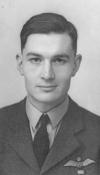
|
The King's School Canterbury |
Roll of Honour |
| Squadron Leader Michael SAVAGE (33370) Croix de Guerre avec Palme | |
|
175 Squadron Royal Air Force Date of birth: 6th April 1918 Date of death: 19th March 1945 Killed in action aged 26 Buried at Rheinburg War Cemetery Plot 17 Row A Grave 2 |

|
| He was born at Wokingham on the 6th of April 1918, the son of George Herbert Savage, mathematics master at Wellington College, coach and examiner, and Marjorie Elizabeth (nee Hinds) of 4, Linksfield Road, Westgate-on-Sea, Kent. He was educated at Hillside School, Reigate, and at the King's School Canterbury from September 1931 to July 1936, where he was in Holme House. He was a King's Scholar, Head of House and a School Monitor. He was also a Sergeant in the Officer Training Corps and Editor of The Cantuarian. He passed in first place in the examinations for the Royal Air Force College, Cranwell in 1936 and passed out in the same year as the King's Cadet. On the 17th of May 1938 Michael Savage took off for a night cross country training flight in Hawker Audax K5124 during which he became lost in the Scarborough area. His aircraft was heard circling for a time and at 3am he baled out of the aircraft. The aeroplane crashed on High Yedmandale farm house, near West Ayton, badly damaging the house but remarkably the five members of the Stonehouse family, who were in the house at the time, managed to escape with minor injuries. Savage landed about a mile and half from the crash site and was taken there by motor car. He was granted a permanent commission as a Pilot Officer in the Royal Air Force on the 30th of July 1938. He was promoted to Flying Officer on the 30th of January 1940 and to Flight Lieutenant on the 1st of December 1940. He was promoted to probationary Squadron Leader on the 30th of January 1941 and was confirmed in his rank on the 1st of March 1942. In 1941 the Cantuarian reported the following:- "M. Savage is having a very busy time in____; his duties are many and varied-one is the giving of exhibitions of flying by day and lectures at night on Army Co-operation to the army at various stations-another is aerial photography, of which he is now one of the chief exponents in ___ ; he has also been training air gunners-a risky job at times, as the inexpert are apt to shoot the tail off their own plane-this has not happened to him! When last heard of was on active service." He saw active service on the North West and Burmese Frontiers and for a year held a staff appointment at Air Headquarters in Delhi. From January 1944 he commanded 175 Squadron which was specially commended for its part in the D Day landings and at Walcheren during which time they were operating Typhoon aircraft in a ground attack role. At 9.20 am on the 19th of March 1945 Michael Savage took off with his squadron in Typhoon Mk 1b HB214-B with orders to attack targets of opportunity on the Hamm railway line. While attacking marshalling yards at Drensteinfurt they were met by a storm of light flak but pressed home their attack with three direct hits being observed on the target. During the attack Michael Savage's aircraft was hit by flak and was seen to spin into the ground near Hamm. He was awarded the Croix de Guerre avec Palme. A school friend said of him:- "Michael made everything that was beautiful more beautiful; he was the grandest person I have ever known." His previously unpublished poems were printed in the Cantuarian after his death; some of his writings and poems were broadcast by the BBC. While he was in Burma he met Sheila Doreen Harvey, the daughter of a local tea planter; they married at Dibrugarh, Assam, India on the 14th of October 1942 and had a daughter, Carolyn, who was born after his death in July 1945. He is commemorated on the war memorial at the Holy Trinity Church, High Hurstwood, near Buxted and on the memorial at Westgate-on-Sea. |
|
| Holme House |
Back